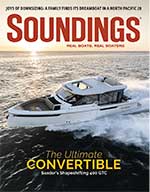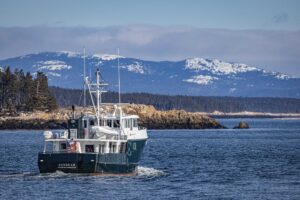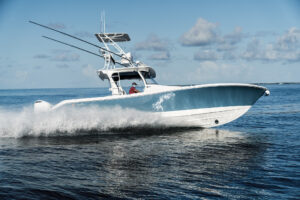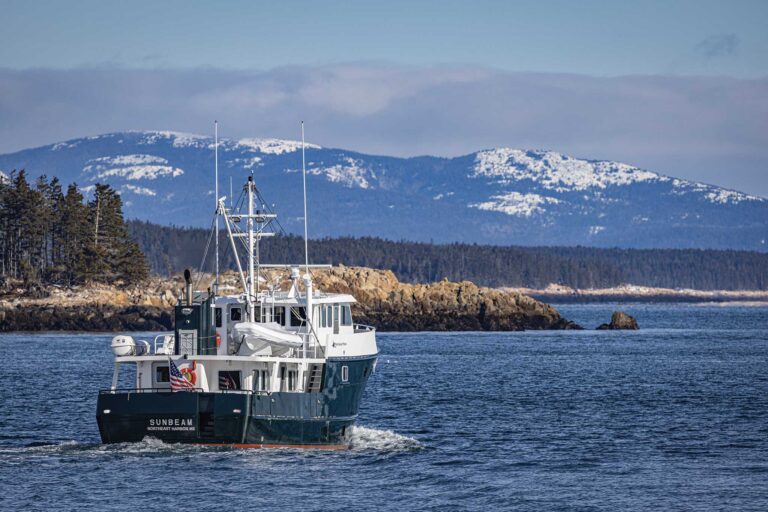Capt. Keith Colburn of ‘Deadliest Catch’ is the face of the Coast Guard’s ‘Boat Responsibly’ campaign
The 40-foot wall of water crashed over the bow of the Wizard’s bow, pushing back 50,000 pounds of chained-down crab pots.

“It was the worst wave I’ve taken at sea,” remembers Keith Colburn, owner and captain of the 156-foot steel-hulled fishing vessel, one of four crab boats featured on the Discovery Channel’s popular show “Deadliest Catch.” “It was one of the worst for two reasons. One, I was at a dead stop, and there was nothing I could do to keep the wave from coming over the bow. Two, I took the wave with the crew exposed to that wave.”
Ironically, when the ship took the wave, Colburn and his crew were taking actions to increase their safety in deteriorating conditions — 45-mph winds and 25-foot seas. “We were trying to deploy a tarp to cut down on the amount of ice buildup on the forward part of the [crab pot] stack,” says Colburn, 46. “We had just dropped 30 pots off to help with our stability.”
But the violent flapping of the tarp made it impossible for Colburn to communicate with the crewmen. “At that point there was nothing I could do but scream to hang on and watch out, and nobody could hear me scream,” Colburn says.
The crew, which includes Colburn’s brother Monte, suffered various injuries. Colburn took the incident hard because he prides himself on maintaining and operating the Wizard at a high level of safety and low risk — a practice he learned from his mentor and previous owner of the boat, John Jorgensen. Colburn runs his crew through long safety drills. Ship systems are checked and double-checked. And every crewmember wears a life jacket on deck — no matter how calm the seas.

Colburn’s stellar safety record made him a natural choice as national spokesman for the Coast Guard’s “Boat Responsibly” initiative that encourages boaters to wear life jackets.
“Everybody looks at the ‘Deadliest Catch’ like it’s the most insane job on the planet — the most dangerous job on the planet,” says Colburn. “It’s kind of ironic to have someone in that profession talking about life jackets, boating responsibly and safety at sea, but it makes sense, because if we don’t think about those things when we leave town, we’re not coming back.”
In its seventh season, “Deadliest Catch” illustrates in dramatic fashion the perils of fishing for crab in the icy Bering Sea, one of the most unforgiving bodies of water on the planet. The show airs on the Discovery Channel and is produced by Original Productions, of Burbank, Calif. Producers sift through 20,000 hours of video to come away with one season, says cameraman/producer Doug Stanley. On each of the show’s eight boats, two fixed cameras on deck and another in the wheelhouse record 24/7. In addition, several other cameras are scattered about the vessel.
“Each season takes at least 90 days of shooting, so that’s an amazing amount of footage,” says Stanley.
The most dramatic action, of course, usually makes it on the show. The “Deadliest Catch” often portrays the fishermen as “working in unsafe conditions, working unsafely and on the edge of capsizing at any given moment,” says Colburn. That’s simply not accurate, he maintains.
“The mariners who work in the Bering Sea are prudent and professional and constantly working to minimize risk and maximize safety,” says Colburn, who has participated in the show for four years.
An open-book personality
At more than 150 feet, the Wizard is the largest of the four main crab boats on the show. Built for the Navy in 1945, she has a 30-foot beam, a gross displacement of 500 tons and draws 13 feet. The vessel’s military background and size attracted the show’s producers, but ultimately the Wizard was chosen because of her captain.
“What’s attractive about Keith and what works for the audience is that he’s not afraid to reveal his emotions — both when he’s angry and when something moves him personally,” says Jeff Conroy, the show’s executive producer. “He’s a guy on camera you see both yelling and crying. As a storyteller, that’s one of the hardest things to find. You don’t write lines for these guys, so you have to find characters that are willing to reveal themselves.”

No one is more aware of Colburn’s open-book personality than cameraman/producer Stanley, who stands right beside him in the wheelhouse filming the skipper. “He cares about his crew so much,” says Stanley. “I’ve got hours of interviews with him crying after the incidents.” Stanley is talking about the handful of dangerous situations the Wizard weathered in what he calls an “epic” 2008-09 season. The 40-foot wave stands out as the most hair-raising and the one that sent Colburn reeling for weeks, according to Stanley.
“All he could talk about was how lucky he was to have his crew alive,” Stanley says. “He was questioning himself a lot — questioning his decisions, even though everything he did was as safe as possible.”
Colburn had given the crew orders to abort the job — covering the traps with a tarp — if conditions got too dangerous. Conditions did get too dangerous, and Colburn tried to call it off, but the noise drowned out his command. Other crewmembers, including Colburn’s brother, went forward to tell the men who were on top of the stack to stop. That’s when the huge wave hit.
“The boat dipped into a trough, and we could see the white water coming,” Stanley remembers. “And Keith yelled ‘Hang on! Everybody hang on!’ ”
The wave slammed into Monte Colburn, who is the first mate and relief captain. “He was moaning and standing there confused,” says Stanley. “He was smashed off the bow, and he was saying, ‘Where’s my crew, where’s my crew?’ It was haunting because the whole scene was just chaos.”
Monte broke a rib. First mate Gary Soper suffered severe facial contusions with possible nerve damage, and deck hand Lynn Guitard received a black eye and bruised back. The captain immediately steamed for Dutch Harbor to seek medical help.
“His acceptance of the responsibility for the incident as his fault and only his fault, regardless of the extraneous factors — that’s what impressed me so much,” says Stanley, who has worked 15 trips on nine different vessels in the Bering Sea fishery for “Deadliest Catch.” “After being with all these guys at sea, in my opinion, Keith is the most diligent on a moment-to-moment basis.”
Ski bum no more
The “Deadliest Catch” has served as a vehicle to promote U.S. commercial fisheries and shows the public the hardships involved in bringing fresh seafood to the dock, says Colburn. “I’ve met a lot of fishermen from other regions like the Gulf Coast and the Eastern Seaboard — lobstermen in Massachusetts and Maine,” he says. “And I think it has helped fishermen in all types of fisheries around the United States.”
The show has also allowed Colburn to document his work and preserve it for his children and grandchildren to see. “That was the initial reason why I decided to do the show,” says Colburn, who has two sons — 13-year-old Caelan and 11-year-old Sienna — with his wife and business partner, Florence, who is 49. “I don’t have a whole lot of historical reference for my children. It’s an incredible opportunity.”
Colburn created his own opportunity 24 years ago when he decided to leave the ski-bum life in Lake Tahoe and journey to Kodiak, Alaska, to work at sea. In 1985 he became a greenhorn on a Bering Sea crab boat, the 135-foot Alaska Trader. He took a job as a deck hand on the Wizard in 1988 and steadily worked his way up the ranks, earning his mate’s license and moving from the deck to the pilothouse in 1990. In 1992, he received his 1,600-ton master’s license and has remained there as skipper.
“The serenity you can feel on the water at times — that’s something that really draws me to the ocean,” says Colburn. “Other times, the hardest part is the isolation and distance and time spent away from the family and your home.”
The Bering Sea crabbing season runs from October through April. The Wizard returns to port 10 times during the season to drop off its catch, but the family sees Colburn only once. “He’s home for about six weeks through the holidays,” says Florence, who runs all off-boat aspects of their business, K.H. Colburn Inc. The two stay in touch via satellite phone and two-way radio, often speaking four to five times daily.
“My kids can pick up the radio any time and hail the Wizard, and their dad is right there. That’s the best part of having the radio,” she says.
About 15 years ago, the only way she could talk to her husband was through ship-to-shore sideband radio. “Keith would call the operator, and he would get in a queue to make a call to a landline,” she says. “While he was waiting for his turn, he would have to listen to every conversation in front of him — both sides. And then when it’s your turn, your conversation is out there for everybody to hear as well.”
Aboard the Wizard
When Colburn bought the former Navy vessel from Jorgensen in 2005, he knew he was getting one of the best commercial fishing vessels in the Bering Sea. “In 1945 the steel was better,” Colburn says. “It was all U.S. steel. It didn’t have additives. They didn’t mix it with stuff. They weren’t using recycled steel to make plating.”
Not only was the quality better, he claims, the construction was better, too. “The ribs are closer together. The hull is all lap-welded instead of butt-welded,” he says. “They don’t make vessels like this anymore. It’s not cost-effective to build a boat the way they built the Wizard.”
Jorgensen, who bought the vessel in 1978, used to work on research boats that were former Navy hulls. “I noticed when we were up in northern waters in the middle of winter how good of a sea boat they were,” says Jorgensen. “So I thought if I got a chance I’d get a hull like that, make a crab boat out of it.”
Jorgensen taught Colburn the importance of running the boat safely and taking no chances. He would often stop fishing in heavy weather while other skippers carried on, endangering their vessels and crews. Jorgensen also stressed the value of proper preparation and vessel maintenance.
“The most important safety lessons are what you do prior to leaving the dock,” says Colburn. “We go through pretty much everything we possibly can prior to setting sail. We have different types of drills. They could be anything from man-overboard to how to use a marine VHF or single sideband radio during an emergency situation. The most important safety lesson I’ve learned is to be well-prepared.”
In his public appearances and service announcements for the Coast Guard, Colburn preaches about preparedness for recreational boaters. “Let everyone aboard your vessel know where the safety equipment is and how to use the marine radio if you have one,” he says. “Always take yourself out of the equation. Make sure [your crew is] prepared for an emergency — without you, the captain. That’s one thing I think recreational boaters fall victim to too many times. The operator of the boat could be the one who gets injured.”
As spokesman for the “Boat Responsibly” initiative, Colburn promotes PFD wear and cites Coast Guard statistics to state his case. For example, there were 709 boating fatalities in 2008, according to the agency’s Recreational Boating Statistics. More than two-thirds of the victims drowned and, of those, more than 90 percent weren’t wearing a PFD.
“Even if it’s flat calm and it’s a beautiful day and you’re an Olympic swimmer, that doesn’t mean that if you fall in the water you’re going to survive without some type of flotation,” he says.
Crewmembers aboard Wizard wear either inflatable vest-style PFDs or jackets with foam flotation. Both are comfortable and provide excellent buoyancy, he says. “The technology has improved dramatically to where today you can wear a PFD and not even know that it’s on,” says Colburn. “My guys are at the point now that it’s like their deck knife. Every man has a little serrated deck knife on his belt, and when you leave the gear room, you almost feel naked without your knife. They feel naked without their PFDs on.”
Colburn also is a firm advocate in the use of EPIRBs. “Anybody that is going offshore any kind of distance should strongly consider or make it mandatory to have an EPIRB on board,” he says. “Even if you file a float plan and you come up missing, it’s a big body of water. If you deviate from your plan and you don’t have communication, you’re on your own. You’re basically a little speck in the sea waiting to be bailed out.”
And it’s not enough to just have an EPIRB, he says. You must know how to properly mount it and how to use it. “If that EPIRB is in a position where you can’t get to it real quickly, then it’s worthless,” says Colburn. He says the Wizard’s EPIRB is mounted on the upper deck at the stern, clear of any antennas or wires and close to the lifeboat station.
Colburn is considering taking safety to the next level by arming his crew with personal locator beacons (PLBs), which can be attached to their PFDs.
The skipper says he spends enough time at sea for work, so in his downtime he rows a scull on the lake next to his home east of Seattle. (Yes, he wears a PFD while rowing.) However, his wife says the couple has dreams of buying a sailboat when they retire. “A 40- to 50-foot vessel that we could sail to the wonderful tropical places around the world,” she says.
But retirement is still a long way off, says Colburn. “I just purchased the boat a few years ago, so I have all of the debt associated with a large purchase,” he says.
When will he haul in the crab pots for good? “The day I start getting gun-shy would be the day I pull out of it,” he says. “If I don’t feel confident going out on the water and making good, quality decisions, that will probably be the day I will hang it up.”
Makes sense for a safety-minded captain like Colburn.
See related article:
– Safety first for the camera crew, too
This article originally appeared in the January 2010 issue.










